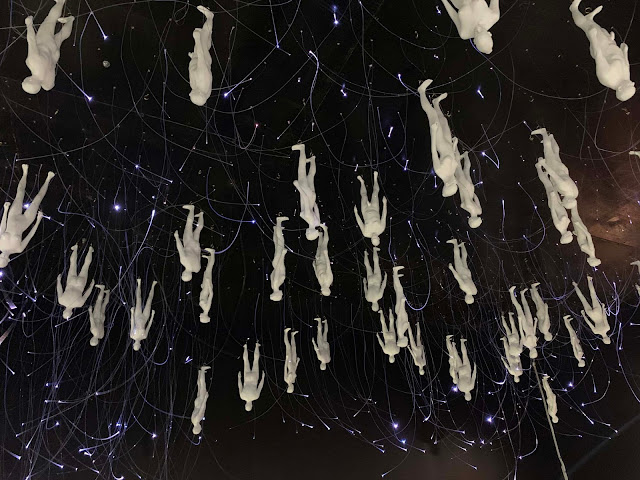I spent minutes looking at photo that showed up today on my "explore" feed. Within the first few seconds, I noticed various shades of blue flooding in from three corners of the photo’s edge. The fourth corner, the top left one, leaves room for a block of a pleasant shade of yellow, which forms a background for a silhouette. The silhouette takes the form of a young woman. She is represented in a gradient blue despite a few discernible features, which are punctuated in pink. An elongated paintbrush is lodged between two fingers of a vibrant pink hand, which is lifted by an arm that is shown in a paler shade of a similar color. A pink nose holds up a white-rimmed pair of glasses, which rest atop a forehead framed by shoulder-length hair. The shoulder lays adjacent to a grid of light squares arranged within a curved shape. The woman faces what appears to be a canvas on an easel. The backside of the canvas, which is faced against the light, can be seen. It is represented by a greenish gray rectangular shadow at the bottom left corner of the photo. From the bottom left corner of the photo, a similar shade of green is repeated in small volumes of what looks to be the woman’s pants. The majority of the space continuing onwards towards the bottom right corner encompasses shifting shades of blue, sweeping up towards the top left corner, where windows curve in and meet the yellow field of color described earlier (which can now be recognized as the back wall of room). The photo is a painted self-portrait of Sigrid Unterwurzacher painting in the studio.
Sigrid Unterwurzacher is studying illustration in Hamburg, Germany. She has been enrolled in her program for approximately a year and has created and shared her artwork for over four years. Unterwurzacher’s creativity began with an interest in depicting characterized figures, but she recently shifted her focus towards the objects and places around her. Her drawings serve as a way to communicate how she is viewing particular objects. As I engaged in a conversation with Sigrid about her entire body of work, it became increasingly clear that her individualized way of “seeing” is her art’s most foundational and inherent value. The immediacy of Sigrid’s work is reliant on her personal visual perception, which she is able to directly show in painted illustrations.
As the artist’s style has developed, she has grown her sense of color and has become more interested in abstraction. She explained how she began simplifying forms and objects: “I pretty much just kept asking myself, ‘how much can I leave out?’” Her usual color palette is approached in a similar manner. “I began illustrating by using all of the colors, and I slowly began refining my palette and taking certain colors out,” she states. Much to my surprise, Unterwurzacher revealed to me that she has never taken a specialized color theory course. Nonetheless, her careful use of color is guaranteed to leave an impression on every viewer of her artwork.
Such perfect combinations of color, abstraction, and forms are a result of study and practice. A keystone component of Sigrid’s creative process is trial and error. “When I don’t like how a piece is starting out, I’ll sometimes flip it upside down and start over, still using parts of what I already have [drawn or painted],” she laughs. In fact, she did so in her self-portrait (my personal favorite piece of hers).
In discussing current and future work, the theme of repetition came up quite often. Several months ago, Unterwurzacher began maintaining a diary in which she documents the places she frequents through sketches. “My friends and I at the university used to visit the same cafeteria spot a lot , so I’ve been sketching that particular place over and over again,” she explains, “but it wasn’t until a friend of mine mentioned that each sketch looked different that I realized I had become interested in the idea of showing the same space in a variety of ways.” The sketches from Sigrid’s diary indeterminately reveal the dependent variables of sight. There is potential for the same space to be shown in multiple ways, even if it’s being shown to us by the same person. This compounding of the one and the multiple is a key theme in most of Unterwurzacher’s illustrations, along with the idea of developing images of a shared world through her own lens.
 |
| Diary sketch of the cafeteria |
 |
| Diary sketch of the cafeteria |
 |
| Diary sketch of Unterwurzacher's room |
 |
| Diary sketch of Unterwurzacher's room |
|
 |
| Diary sketch of Unterwurzacher's room |
|
 |
Diary sketch of Unterwurzacher's room
|
|
You can look forward to more of Sigrid Unterwurzacher's artwork by following her on Instagram (@siuntee).
 |
Unterwurzacher's Self Portrait
|









Comments
Post a Comment